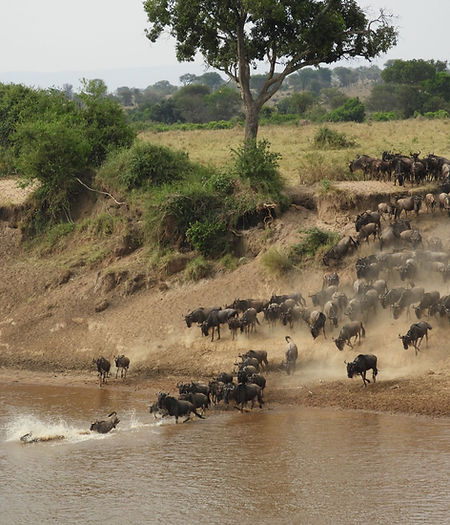top of page


Tanzania, renowned for its breathtaking landscapes and abundant wildlife, offers a rich safari experience that varies with the changing seasons. The country’s safari seasons are primarily shaped by its distinct wet and dry periods, each offering unique opportunities for wildlife viewing. The dry season, from June to October, is considered the best time for game drives, as animals gather around water sources and vegetation is sparse, making sightings more frequent and dramatic. Conversely, the wet seasons—from November to May—bring lush green scenery, migratory birds, and fewer tourists, offering a more serene and intimate experience. Understanding these seasonal shifts is key to planning a memorable Tanzanian safari adventure.
June to October
The Great Migration – Mara River Crossing in Northern Serengeti
The Mara River crossing is one of nature’s most thrilling and dramatic wildlife spectacles — a true highlight of the Great Migration in northern Tanzania. Taking place between July and October, this incredible event sees hundreds of thousands of wildebeest, zebras, and gazelles risk everything as they plunge into the treacherous waters of the Mara River, battling strong currents and lurking predators.
Set against the stunning backdrop of the northern Serengeti, near the Kenya border, this unforgettable scene draws wildlife enthusiasts and photographers from around the world.
🐾 Key Highlights of the Mara River Crossing
📅 Timing:
The crossings typically occur from late July to early October, as the herds push north into Kenya’s Masai Mara in search of greener pastures.
📍 Location:
The action is centered in the northern Serengeti, particularly in the Kogatende area, where the Mara River meanders through the savannah landscape.
⚠ The Challenge:
Crossing the Mara River is perilous. Wildebeest and zebras face powerful currents, steep riverbanks, and ambushes by crocodiles and lions. Many don't make it — a sobering but essential part of the migration cycle.
🌍 The Spectacle:

November to May
Wildebeest Calving Season – Nature’s Greatest Nursery in Southern Serengeti
The wildebeest calving season is one of the most dramatic and awe-inspiring events in the African wildlife calendar. Occurring from late January to early March, this period coincides with the southern phase of the Great Migration and draws visitors from around the world to Northern Tanzania’s southern Serengeti and Ndutu region.
Each year, over half a million wildebeest calves are born within just a few weeks, alongside thousands of newborn zebras and gazelles. The sheer volume of wildlife, paired with heightened predator activity, creates an unforgettable safari experience.
🌿 Why the Calving Season Is Special
Peak Calving Period:
The birthing season peaks between late January and February, when the majority of wildebeest give birth almost simultaneously. This brief but intense window is crucial for the survival of the calves.
Prime Location:
The Ndutu region and southern Serengeti plains offer front-row seats to this spectacle. These nutrient-rich grasslands provide the perfect conditions for birthing and early grazing.
Abundant Wildlife:
During this time, the plains are filled with vast herds of wildebeest, zebras, and gazelles — a true wildlife wonder.
High Predator Activity:
The arrival of so many vulnerable newborns attracts predators such as lions, cheetahs, hyenas, and leopards, making this an ideal time for wildlife photography and witnessing raw nature in action.
Part of the Great Migration:
The calving season marks a critical chapter in the Great Migration. After calving, the herds begin their long journey north toward central and later northern Serengeti.
Safari Experience:
Lodges and mobile camps in the Ndutu and southern Serengeti areas offer exclusive access to calving grounds. Visitors can enjoy daily game drives, hot air balloon safaris, and guided bush walks for a deeper connection with the wild.
📅 Best Time to Visit
For those looking to witness the circle of life unfold before their eyes, the best time to visit is from late January through early March. This short season offers unmatched opportunities to observe not just the miracle of birth, but also the natural drama that surrounds it.
bottom of page